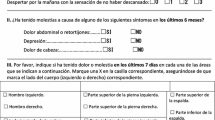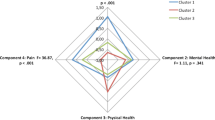Abstract
Background
Although a large body of work indicates that fibromyalgia (FM) is not a discrete entity, few studies have attempted to classify the heterogeneity of FM symptoms. The objectives of the present study were to confirm the existence of two latent dimensions underlying FM symptoms (Core-FM symptoms and Distress) by means of factor analysis techniques, and to develop and validate a new combined index of symptom severity (the CODI).
Methods
We analyzed and combined the baseline scores on six visual analog scales of the FIQ (pain, general fatigue, morning fatigue, stiffness, anxiety, and depression) and on the STAI-T (trait anxiety) of 216 Spanish patients diagnosed with FM (97.7% women) who were participating in a randomized, controlled trial.
Results
The principal component analysis indicated the presence of two correlated factors (labeled as Core-FM symptoms and Distress) that explained 64% of total variance. The subsequent confirmatory factor analysis yielded more empirical support for the two-factor model than the one-factor model (all items loading on one latent dimension). The two factors possessed adequate internal consistency and construct validity given the pattern of significant correlations with the Euroqol items. The Core-FM dimension had a stronger relationship with mobility, self-care, usual activities, and pain/discomfort than with anxiety/depression, whereas the Distress dimension showed the opposite pattern. Finally, summing the standardized scores of the two dimensions, a new combined index of symptom severity (the CODI) was developed.
Conclusion
The clinical implications and utility of the CODI are discussed in relation to previous research on FM.


Similar content being viewed by others
References
Wolfe, F., Smythe, H. A., Yunus, M. B., et al. (1990). The American College of rheumatology 1990 criteria for the classification of fibromyalgia. Report of the Multicentre Criteria Committee. Arthritis and Rheumatism, 33, 160–172.
Burckhardt, C. S., Clark, S. R., & Bennett, R. M. (1991). The Fibromyalgia Impact Questionnaire: Development and validation. Journal of Rheumatology, 18, 728–733.
Clauw, D. J., & Crofford, L. J. (2003). Chronic widespread pain and fibromyalgia: What we know, and what we need to know. Best Practice & Research Clinical Rheumatology, 17, 685–701.
Nampiaparampil, D. E., & Shmerling, R. E. (2004). A review of fibromyalgia. American Journal of Management Care, 10, 794–800.
Turk, D. C., Okifuji, A., Sinclair, J. D., & Starz, T. W. (1996). Pain, disability, and physical functioning in subgroups of patients with Fibromyalgia. Journal of Rheumatology, 23, 1255–1262.
Naschitz, J. E., Rozenbaum, M., Rosner, I., Sabo, E., Priselac, R. M., Shaviv, N., et al. (2001). Cardiovascular response to upright tilt in fibromyalgia differs from that in chronic fatigue syndrome. Journal of Rheumatology, 28, 1356–1360.
Hurtig, I. M., Raak, R. I., Kendall, S. A., Gerdle, B., & Wahren, L. K. (2001). Quantitative sensory testing in fibromyalgia patients and in healthy subjects: Identification of subgroups. Clinical Journal of Pain, 17, 316–322.
Rutlegde, D. N., Mouttapa, M., & Wood, P. B. (2009). Symptom clusters in fibromyalgia: Potential utility in patient assessment and treatment evaluation. Nursing Research, 58, 359–367.
Wilson, H., Starz, T. W., Robinson, J. P., & Turk, D. C. (2009). Heterogeneity within the fibromyalgia population: Theoretical implications of variable tender point severity ratings. Journal of Rheumatology, 36, 2795–2801.
de Souza, J. B., Philippe, G., Vaux, P. G., Julien, N., Potvin, S., Charest, J., et al. (2009). Fibromyalgia subgroups: Profiling distinct subgroups using the Fibromyalgia Impact Questionnaire. A preliminary study. Rheumatology International, 29, 509–515.
Calandre, E. P., Garcia-Carrillo, J, Garcia-Leiva, J. M., Rico-Villademoros, F., Molina-Barea, R., & Rodriguez-Lopez, C. M. (2010). Subgrouping patients with fibromyalgia according to the results of the Fibromyalgia Impact Questionnaire: A replication study. Rheumatology International 2010 May 20. [Epub ahead of print].
Stratz, T., Varga, B., & Muller, W. (2003). The influence of depression on the effect of Tropisetron in the therapy of fibromyalgia. Zeitschrift fur Rheumatologie, 62, 42–45.
Grossman, P., Tiefenthaler-Gilmer, U., Raysz, A., & Kesper, U. (2007). Mindfulness training as an intervention for fibromyalgia: Evidence of postintervention and 3-year follow-up benefits in well-being. Psychotherapy and Psychosomatics, 76, 226–233.
Thorn, B. E., Boothby, J. L., & Sullivan, M. J. L. (2002). Targeted treatment of catastrophizing for the management of chronic pain. Cognitive and Behavioral Practice, 29, 127–138.
Luciano, J. V., Martínez, N., Peñarrubia-María, M. T., Fernández-Vergel, R., García-Campayo, J., Verduras, C., et al. (2011). Effectiveness of a psychoeducational treatment program implemented in general practice for fibromyalgia patients: A randomised controlled trial. Clinical Journal of Pain, 27, 383–391.
Fernández, R., Peñarrubia, M. T., Luciano, J. V., Blanco, M. E., Jiménez, M., Montesano, A., et al. (2008). Effectiveness of a psycho-educational programme for improving quality of life of fibromyalgia patients. BMC Musculoskeletal Disorder, 9, 2.
World Health Organisation (WHO). (2002). Innovative care for chronic conditions: Building blocks for action. Geneva.
Rivera, J., & González, T. (2004). The Fibromyalgia Impact Questionnaire: A validated Spanish version to assess the health status in women with fibromyalgia. Clinical and Experimental Rheumatology, 22, 554–560.
Spielberger, C. D., Gorsuch, R. L., Lushene, R. E., Vagg, R. E., & Jacobs, G. A. (1983). Manual for the state-trait anxiety inventory. Palo Alto, CA: Consulting Psychologists Press.
Badía, X., Roset, M., Montserrat, S., Herdman, M., & Segura, A. (1999). Spanish version of EuroQoL: Description and applications. Clinical Medicin, 112, 79–86.
Badia, X., Schiaffino, A., Alonso, J., & Herdman, M. (1998). Using the EuroQoI 5-D in the Catalan general population: Feasibility and construct validity. Quality of Life Research, 7, 311–322.
Kaiser, H. F. (1974). Analysis of factorial simplicity. Psychometrika, 39, 31–36.
Bartlett, M. S. (1954). A note on the multiplying factors for various Chi-square approximations. Journal of the Royal Statistical Society: Series B, 16, 296–298.
Jöreskog, K. G., Sörbom, D. (2007). LISREL 8.80. Chicago, IL: Scientific Software International, Inc.
Schumacher, R. E., & Lomax, R. G. (1996). A beginner’s guide to structural equation modeling. Mahwah, NJ: Lawrence Erlbaum.
McDonald, R. P., & Marsh, H. W. (1990). Choosing a multivariate model: Noncentrality and goodness of fit. Psychological Bulletin, 107, 247–255.
Cohen, J. (1988). Statistical power analysis for the behavioral sciences (2nd ed.). New York, NY: Academia Press.
Metz, C. E. (1978). Basic principles of ROC analysis. Seminars in Nuclear Medicine, 8, 283–298.
Bennett, R. (2005). The Fibromyalgia Impact Questionnaire (FIQ): A review of its development, current version, operating characteristics and uses. Clinical and Experimental Rheumatology, 23(Suppl. 39), S154–S162.
Hadjistavropoulus, H. D., Asmundson, G. J. G., & Kowalyk, K. M. (2004). Measures of anxiety: Is there a difference in their ability to predict functioning at three-month follow-up among pain patients? European Journal of Pain, 8, 1–11.
Keedwell, P., & Snaith, R. P. (1996). What do anxiety scales measure? Acta Psychiatrica Scandinavica, 93, 177–180.
Vallejo, M. A., Rivera, J., Esteve-Vives, J., & Group, I. C. A. F. (2010). Development of a self-reporting tool to obtain a combined index of severity of fibromyalgia (ICAF). Health Qual Life Outcomes, 8, 2.
Mas, A. J., Carmona, L., Valverde, M., & Ribas, B. (2008). Prevalence and impact of fibromyalgia on function and quality of life in individuals from the general population: Results from a nationwide study in Spain. Clinical and Experimental Rheumatology, 26, 519–526.
Kass, R. A., & Tinsley, H. E. A. (1979). Factor analysis. Journal of Leisure Research, 11, 120–138.
Sullivan, M. J. L., Bishop, S. R., & Pivik, J. (1995). The Pain Catastrophising Scale: Development and validation. Psychological Assessment, 7, 524–532.
Acknowledgments
The FibroQoL research project was funded by a grant from the “Agència d’Avaluació de Tecnologia i Recerca Mèdiques” (AATRM 077/25/06). JVL is grateful to the “Instituto de Salud Carlos III” (Red RD06/0018/0017) for a postdoctoral contract. To date, the Fibroqol study has received two research awards: the “III International award of psychological research in fibromyalgia, Premio Celeste” awarded by the Asociación Vasca de Divulgación de la Fibromialgia “Gaixoen Ahotsa” (ADFM) and the “IV award for innovation in primary care” awarded by the Catalan Department of Health, the Catalan Society of Family and Community Medicine, and the Association of Family and Community Nursing of Catalonia. The authors would like to thank all of the participants and especially Prof. FJ Baron for his help in developing the web calculator. This research was partially funded by grants from the OTRI-UMA (ref 806/423505 code 00334). We would like to acknowledge the FibroQoL group’s valuable assistance in data collection (General practice Gavà 1: Francisco J. Gómez, José L. Caballé, Amelia Prieto, Elena Carrera, Eva Alonso, Laura Pérez, Nuria Gutiérrez, Rosa M. Aranzana, Montserrat Espuga, Jugo Jiménez. General practice Gavà 2: Mariona Soler, Emilia Caramés, Estíbaliz Redondo, Inma García, Ángel Espín, Carmen Almirall, Josep Verdú, Lola Ruiz, Margarita García, Marta Sanavia. General practice Viladecans 2: María C. García, Alicia Valer, Noelia Esplugas, María D. González, Estefanía San Juan, Adela Viniegra, Caterina Calvet, Cristina Montblanc, Rosa Vilafáfila, Pere Simonet, Luis López, Rosa Ramírez, Ángela Muñoz, Carmen Bentue).
Conflict of interest
All authors declare that there is no conflict of interest.
Author information
Authors and Affiliations
Consortia
Corresponding author
Rights and permissions
About this article
Cite this article
Cuesta-Vargas, A., Luciano, J.V., Peñarrubia-María, M.T. et al. Clinical dimensions of fibromyalgia symptoms and development of a combined index of severity: The CODI index. Qual Life Res 22, 153–160 (2013). https://doi.org/10.1007/s11136-012-0134-6
Accepted:
Published:
Issue Date:
DOI: https://doi.org/10.1007/s11136-012-0134-6




